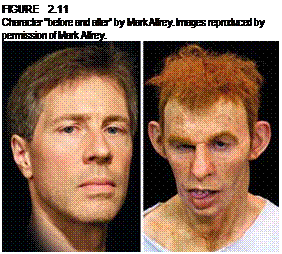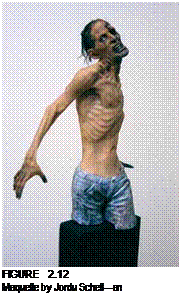Creating an effective, memorable character makeup is dependent on several things. What is the medium in which the character will be viewed? Is this a character makeup for the stage or screen? Since essentially everything in a stage production will be viewed by the audience in a "wide shot," the makeup must reflect the reality of the medium. Even makeups designed for the screen must often be bigger than life. Noted character artist Steve Wang has said that when you sculpt a character, you tend to make the detail more exaggerated than in real life because you want those details to show up. "Although we are very often inspired by nature, our aim is not always to reproduce nature—our work is very theatrical and is there to serve the movie," he says.[2]
It also has to be a design that, when fabricated and applied, will allow the actor to wear it and perform in it. For film and television, it becomes important for makeup artists to be in sync with the director of photography so that the makeup—and so the performer—will be photographed in the best possible way to achieve the storytelling objectives. In theater, lighting is the critical element with which to be in sync. How a makeup appears under certain lighting conditions can help or hurt a performance. Story and performance should always take precedence over makeup.
 Crucial physical information you need to know about your character before you begin to design should include (but certainly should not be limited to) the following:
Crucial physical information you need to know about your character before you begin to design should include (but certainly should not be limited to) the following:
■  What is the character’s general physiology and body shape?
What is the character’s general physiology and body shape?
■ Is the character nonhuman or animal-like? What does it resemble—a mammal, bird, reptile, amphibian, insect?
■ Does the character have wings or a tail?
There are three somatotypes, or body types, associated with men and women: ectomorphic, mesomorphic, and endomorphic. These body types were described by American psychologist William Sheldon, who began his research with 4,000 photographs of college-age men which showed front, back, and side views. From the study of these images, Dr. Sheldon saw that there are three fundamental elements that, when combined, made up these three physical body types.[3] No one is wholly one of the three without having at least some of the other two at the same time in varying degrees.[4]
 The ectomorphic body type is characterized by long arms and legs and a short upper body with narrow shoulders.
The ectomorphic body type is characterized by long arms and legs and a short upper body with narrow shoulders.
In addition, ectomorphs are characterized by:
■ Thin physique
■ Small bones
■ Flat chest
■ Youthful in appearance
■ Lightly muscled
■ Very little body fat
■ High metabolism
■ Tall
The literary character of Ichabod Crane (The Legend of Sleepy Hollow) is an example of a classic ectomorph.
The mesomorphic body type is characterized by a high rate of muscle growth and a higher proportion of muscle tissue. Mesomorphs have large bones and a solid torso combined with low body fat levels. They are also characterized by:
■ Broad shoulders
■ Narrow waist
■ Overly mature appearance
■ Physical strength
■ Large chest
■ Long torso
■ Thick skin
The character Tarzan is a classic mesomorph.
The endomorphic body type is characterized by an increased amount of body fat. Endomorphs have wide waists and hips and large bone structure. They are also characterized by:
■ Soft body
■ Slow metabolism
■ Round-shaped body
■ Round face
■ Short neck
■ Low muscle mass
Santa Claus is our society’s ideal endomorph.

Obviously you’ll need to consider variations within each of these somatotypes when designing your character as well. Dr. Sheldon evaluated the degree to which a characteristic was present on a scale ranging from one to seven, with one being the minimum and seven the maximum of a particular somatotype.[5]
![]()
In assessing a character’s body type, other variables to consider may include:
■ Is the character from classic fiction, popular culture, or previously unknown?
■ Is the genre of the character horror, science fiction, fantasy, or reality?
■ Is the character animal, vegetable, or mineral?
■ What is the character’s gender?
■ Does the character have skin? If so, what is the color, texture, and hairiness? Are there variations of these characteristics over the body?
■ Does the character have fur? Feathers? Scales? A shell or bony armor?
■ How will the character’s coloring affect audience perception?

What about stereotypes? Stereotypes are based in reality but tend to be a gross oversimplification of an observed or perceived trait of behavior or appearance. If you can add familiarity to your character and makeup design without becoming inappropriate or offensive, then do so. However, remain sensitive when dealing with cultural and symbolic elements that may affect your design.
FIGURE 2.13
 |
Design for a children’s theater production of Lilly’s Purple Plastic Purse. Photo by the author.
FIGURE 2.15
Actor Nick Sugar from Bat Boy: The Musical. Photo by the author.
In designing special makeup effects you must remember that you can add to, but not take away from, a makeup if an actor is going to be wearing prosthetics. There must also be a basis in the reality of biology and physiology; a character with an enormous head, neck, and chest but a lower torso and waist barely large enough only for the spine and little else is not likely to have survived long enough as a species to evolve, let alone grow to adulthood with such a physique. The sheer weight of the head, neck, and upper body would topple, splintering the spine like a toothpick, not to mention the question of where the abdominal organs and digestive tract are supposed to be. In creating even a fantasy character, there must be a basis in reality, in human anatomy, especially if a human actor has to wear it, even if it is a nonhuman character makeup!
